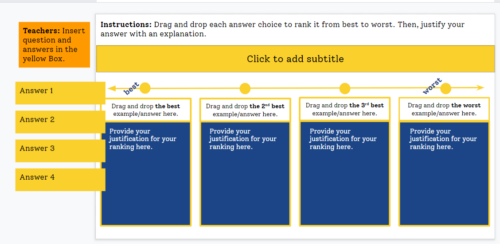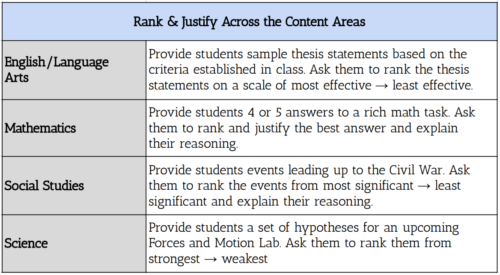There’s almost this ‘holy grail’ feeling when you find a strategy that not only works across grades and content areas, but also promotes collaboration and cognitive engagement. For me, one of these strategies is Sort, Rank & Justify.
Sorting might not be new to many of you. By no means can I (or do I) take credit for this idea. I remember being in my methods class at the University of Delaware and reading an early edition of Words Their Way (Donald Bear, Marcia Invernizzi, et al). This resource included sorts where students were developing an understanding of spelling patterns by sorting words into columns that fit the “rule” or criteria.
I remember thinking then, “This makes so much sense!” Students were building a deeper understanding of the words by exploring the similarities and differences. Couldn’t this concept work across disciplines — beyond spelling and word work? The answer was a resounding YES!
That was 20 years ago and to this day I use sorting in classrooms. Over the years, more research and resources have come out about the instructional benefits of sorting. While you might often see this practice used in early childhood education, the benefits of sorting and categorizing content stretch far beyond those beginning years of school.
“Classifying and sorting activities help children to develop a range of thinking skills and build the foundations for later problem-solving. The visual memory and discernment involved, and the ability to identify patterns, relationships, similarities and differences, assists children in learning…and problem-solving.”- Nest Kids
The book Total Participation Techniques: Making Every Student an Active Learner, Himmele & Himmele include Sorting and Categorizing, as well as Ranking, among their strategies. “The process lends itself to the analysis of components inherent in the concepts being taught” (p. 78). Working side-by-side with teachers, I often hear struggles with balancing the coverage of content with in-depth, rigorous learning. Thes strategies not only give students an opportunity to interact with content, but to develop complex reasoning as to how ideas and concepts relate to one another.
So, how do they work?

Sort
When asking students to sort, it might go one of two ways:
Closed Sort
A closed sort has the headings or categories provided to the students. The teacher determines the names and features of the different categories and provides students with items or lists to sort within these given categories.
The essential next step after sorting is the explanation. Students need to explain WHY they sorted that item into the category they did. The explanation puts students into Webb’s Depth of Knowledge Level 3: Strategic Thinking as they draw conclusions about the similarities, differences, and connections between those concepts.
Closed Sorting is a great first step in your classroom. It familiarizes students with the process of sorting and builds their skill in using evidence to support their explanation—an essential cross-cutting standard in many curricula.

Here are just a few ideas from teachers who have used Closed Sorts across content areas:

Open Sort
Open sorting (or categorizing) provides a leveled-up learning opportunity for students to analyze content, draw conclusions, and use complex reasoning. With this process, students are simply given items or a list related to their current unit of study or learning target (no headers or categories are provided). Independently or collaboratively, students form groups or categories with the items given to them. Once sorted, students create a title or name for the group which reflects their rationale as to how those items were connected.
The open-ended nature of this type of sorting allows for multiple answers, rather than a correct answer, which is more typical of the closed sort explained above. If students have a rationale as to how those items are grouped, it demonstrates an understanding of the content and how the concepts relate to one another.
Here are possible next steps with an open-sort that continue to engage students in higher-order thinking and application:
- Once sorted, ask students or groups to now sort the same content in a different way. This helps students consider multiple ideas and moves away from their being a singular “right” answer.
- If working collaboratively — each group nominates a docent to stay back with their sorted categories. Other students “tour” the room looking at their classmates’ sorts. Ask students to compare and contrast the categories they noticed. “Are they similar or different? Why might that be?”
- Provide students with a set of vocabulary cards connected to the unit (note: these must be words students have had previous exposure to prior to the activity). Challenge students to use the vocabulary in their category title.

Here are just a few samplings of ways teachers have used Open Sorts across content areas:

Google Draw Categorizing Template
Rank & Justify
The final layer of this work is Rank and Justify. This strategy can be paired with either sort type mentioned above or can be used as a standalone strategy. Rank & Justify taps into the highest level of Bloom’s Taxonomy or Webb’s Depth of Knowledge which asks students to evaluate ideas and make judgments.
With this strategy, provide students with 4-5 items — these could be responses to a question, model answers to a prompt, or examples of student work (teacher or student-generated). Independently or collaboratively students look at the items and rank them based on the criteria established.
Using worst → best or weakest → strongest parameters as a guide, students rank items on a continuum and explain the rationale for their ranking. This last step is essential. Having students explain their ranking against the set criteria provided allows them to interact with the content at high cognitive levels.

Level-Up Rank & Justify:
- Have students co-create or create the list of criteria that would make the best or strongest response.
- Leverage the Rank & Justify exercise into a class debate. Encourage students who rank different ideas or responses higher to defend their thinking.
- Carve out additional time for students to research facts, statistics or additional evidence to strengthen their argument.
Here are just a few samplings of ways teachers have used Rank & Justify across content areas:

Planning considerations
A few final thoughts as you consider integrating Sort, Rank & Justify into your classroom instruction.
- These strategies work best when teaching content where students are asked to compare/contrast information or understand the relationships or connections between different concepts.
- Sort, Rank & Justify can be used for independent class work, small group instruction, station rotation, student playlists, collaborative group work, or assessment.
- These strategies can be used at different parts of the learning process:
- Sorting can be used as an introductory inquiry activity to pre-assess students’ understanding of content. If used in this way, remember to give students another opportunity to engage with sorting the same content to see growth over time.
- Sorting or Ranking could also be used during the learning process as an opportunity for students to apply content knowledge.
- They can also be used as assessments — often hitting several standards and/or learning targets in one experience.
- Finally, these strategies work well on paper (print, cut, place in an envelope or baggie) or digitally (Google Slides, Google Drawing, Microsoft Office, etc.).
Filling our instructional toolbox with high-impact strategies that can be used across contents and units of study not only streamlines our workload, but allows students to build success as they engage in high-level thinking, complex reasoning, and collaboration over time. Sort, Rank & Justify is a powerhouse trio that provides students with open-ended approaches to understanding content while also encouraging a bit of fun!

Katie McGrath
Middle School Instructional Coach
Sign up to get new Truth for Teachers articles in your inbox
OR

Join our
community
of educators
If you are a teacher who is interested in contributing to the Truth for Teachers website, please click here for more information.

















